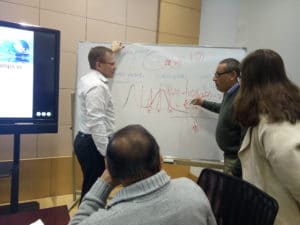
Compliance testing is a fundamental component of a lighting monitoring, verification and enforcement (MVE) scheme. It allows for the verification of whether products live up to their energy-efficiency claims. Without such ongoing, effective market control activities, noncompliant lighting products enter markets, disappoint users, and reduce expected energy and financial savings.
As for many other countries, lighting compliance testing has proven to be a challenge for Peru. Current testing laboratory capacity in the country is limited and in need of an upgrade. Four Peruvian experts representing two national laboratories, the national quality standards institute, and the Ministry of Energy and Mines attended the training.
Overall, participants obtained useful information to further strengthen quality control and testing capacities in Peru.
The Global Efficient Lighting Centre promotes the rapid development of energy-efficient lighting technologies around the world. It was launched in September 2011, as a UN Environment Collaborating Centre for Energy Efficient Lighting and a partnership between UN Environment and the National Lighting Test Centre of China. The Centre provides lighting testing, training, advice, quality control and capacity building support to developing and emerging countries.
The “Lighting Market Transformation in Peru” project funded by the Global Environmental Facility kicked off in 2015. The Peruvian Ministry of Energy and Mines leads it, with the support from United for Efficiency-en.lighten initiative.
Resources:
Lighting Compliance Testing: Training Workshop Report and Agenda
How Does A Lighting Laboratory Play Its Role In Quality Control
Lighting Technology Development and Trend
The Key Findings of Failures in the Lighting Test
Fundamentals of Photometry and Colorimetry
The Common Issues in Lighting Test and Potential Solutions
Overview of International Lighting Standards